Buffalo Stampede Read online
BUFFALO STAMPEDE
BUFFALO STAMPEDE
A WESTERN STORY
by
ZANE GREY
First Skyhorse Publishing edition published 2013 by arrangement with Golden West Literary Agency
Copyright © 2011, 2013 by Zane Grey, Inc.
An earlier version of Buffalo Stampede first appeared as a twelve-part serial titled “The Thundering Herd” in The Ladies’ Home Journal (2/24-1/25). Copyright © 1924, 1925 by Zane Grey. Copyright © renewed 1952, 1953 by Zane Grey, Inc. Copyright © 2011 by Zane Grey, Inc., for restored material.
All Rights Reserved. No part of this book may be reproduced in any manner without the express written consent of the publisher, except in the case of brief excerpts in critical reviews or articles. All inquiries should be addressed to Skyhorse Publishing, 307 West 36th Street, 11th Floor, New York, NY 10018.
Skyhorse Publishing books may be purchased in bulk at special discounts for sales promotion, corporate gifts, fund-raising, or educational purposes. Special editions can also be created to specifications. For details, contact the Special Sales Department, Skyhorse Publishing, 307 West 36th Street, 11th Floor, New York, NY 10018 or [email protected].
Skyhorse® and Skyhorse Publishing® are registered trademarks of Skyhorse Publishing, Inc.®, a Delaware corporation.
Visit our website at www.skyhorsepublishing.com.
10 9 8 7 6 5 4 3 2 1
Library of Congress Cataloging-in-Publication Data is available on file.
ISBN: 978-1-62873-445-4
BUFFALO STAMPEDE
Foreword
On April 1, 1923 Zane Grey left Long Key, in Florida, where he had been vacationing and fishing, to go to New York to continue negotiations with magazine publishers. He reached a tentative agreement with The Ladies’ Home Journal to write two serials a year for $30,000 each and he agreed with The Country Gentleman to do two serials a year for that magazine at the same price. In terms of newsstand competition such an arrangement presented no problem to the management of these magazines since both belonged to The Curtis Publishing Company, also publisher of The Saturday Evening Post. The challenge for Grey was could he actually write four 80,000-word books of comparable quality in one year? He thought he might, but as it turned out he couldn’t, and didn’t even try.
Returning to California, Grey learned from his wife Dolly that she had decided to take a long vacation herself. What Dolly had in mind was an automobile drive across the country to Lackawaxen in Pennsylvania, where she would stay for a few weeks, followed by a trip to Europe. The vacation would last more than four months. She would leave their three children behind in California with their father. In a way the entire trip was a protest against Grey’s womanizing.
Grey did not stay at the family home in Altadena but went instead to live in the Southwestern-style home he had built on Catalina Island because the fishing season had opened and he hoped to begin work at once on a new magazine serial. Mildred Smith would act as his secretary. Later, as a gift for her, he would build her a house that was a replica in miniature of his Catalina Island home. On April 30, 1923 he recorded in his diary:
I have begun to write again. Another romance! The epic of the buffalo. The Thundering Herd. Where do I find these romances? That query has been promulgated by critics and reviewers who have never been west. I see these romances, and I believe them. Somewhere, sometime, they happened. My reward and my faith in myself come from the many letters I get from simple readers—old women, and young girls and boys, to all with hearts full of romance, all true to the children in them.
The subject of the new story and how it was to be treated had been inspired by the many stories Buffalo Jones had told him about buffalo hunting in the 1870s, a process that had led finally to the decimation of virtually all of the buffalo. For Grey the tone of his story was an elegy to these great, noble beasts and a sadness over their wanton execution for the sake of greed and, secondarily, as a way of conducting a war of attrition against the Plains Indians whose livelihood depended on the great buffalo herds. He had started the story while Dolly was still in California and named his heroine Molly Fayre. He had written perhaps the first hundred pages by hand when Mildred Smith joined him at the Catalina home. It was then that he changed the heroine’s name to Milly Fayre. Every time he would write Molly in error, he would go back, cross out that name, and write Milly above it. In transferring this holo-graphic manuscript to type, Grey’s first name for his heroine, Molly, has been retained.
In a diary entry, written late in the night of June 4, 1923, Grey noted:
It is now far into the night. I can hear the wash of the surf on the beach and the melancholy chirp of the crickets. The night seems dark, cold, lonely. I have just finished The Thundering Herd, after writing all day and up to now. I am tired. My arm aches. My head boils. My feet are cold. But I am not aware of any weakness.
I do not feel that I have done well in the writing of this romance of the buffalo. Always I have that feeling at the end of work. I seem to have failed in the great epic strife I set out to picture. But the story went on of itself and was not what I planned. And now it must stand or fall.
This was the first time Dolly was not there to go over his manuscript and edit it for him. It is probable that Dolly felt that Doc, as she called her husband, should let that task to Milly Smith and see what happened.
The manuscript, after being typed, was sent to Barton Currie, editor of The Ladies’ Home Journal. Currie had problems with the story as written. For example, in the battle between the buffalo hunters and the Comanches, the narrative reached a point where Tom Doan, the youthful hero, had ventured back toward the horses to fetch canteens for the fighting men and the wounded, only to be shot at from ambush by a Comanche warrior. Doan sees the Comanche rise up before him. At this point the narrative stops and resumes with the story of Molly Fayre, who is again captive of Randall Jett. When Grey does go back to the battle with the Comanches, it is as a narrative being told by Tom Doan to some young and eager listeners. Grey often resorted to this narrative device. After all, and certainly in this case, it was how he himself had first heard of so many events of the great buffalo hunt from Buffalo Jones, about whom he wrote a book, The Last of the Plainsmen, published in 1908, and who was a character he included in this novel. Currie’s point was that Grey should carry on the battle to its end and not rely on a back-telling device later on in the story. He also had numerous other objections, calling for revisions, not the least Grey’s tone in some of the scenes.
Grey rewrote his narrative accordingly. He had no choice, if he wanted The Ladies’ Home Journal to purchase it. Here is how he originally ended the battle with the Comanches, as told by Tom Doan:
“The horses were brought, and the dead men were hung over their saddles. Miller died unconscious. It was a strange sad procession that reached camp. I was too sick to get up, once I fell off my horse. Our wounds were washed and dressed. Next morning, we buried our dead and broke camp, the worst of the cripples riding on the wagons. That night we were down off the Staked Plains. In three days we reached the Pease River camps, to spread the news and get ready for another campaign against the Comanches.”
Here is how Grey had to revise it. Pilchuck, the scout leading the buffalo hunters, is the speaker:
“Boys,” he said, “I never expected any of us to get out of that fight alive. When those yellin’ devils charged us I thought the game was up. We did well, but we were mighty lucky. It’s sad about our comrades. But some of us had to go an’ we were all ready. Now the great good truth is that this victory will rouse the buffalo-hunters. I’ll go after more men. We’ll shore chase the Comanches an’ Kiowas off the Staked Plain, an’ that will leave us free to hunt buffal
o. What’s more important, it will make Texas safe for settlers. So you can all feel proud, as I do. The buffalo-hunters will go down in history as havin’ made Texas habitable.”
Grey was furious about what he had to do, but he did it. There was no second Grey serial in The Ladies’ Home Journal in 1924. It was only when Dolly Grey, after her return from Europe, smoothed matters over at the magazine that “The Bee Hunter” was serialized in 1925, but that also proved to be the last serial that Grey would write for The Ladies’ Home Journal.
There is no triumphalism in Buffalo Stampede as Zane Grey wrote it. As he had intended, it is the story of the passing of the buffalo, powerfully moving and in a way saddening. Grey’s first draft reflects what he felt and with all its narrative devices, so unsuited to magazine serialization, and its tone, again believed to be unsuitable for the readers of The Ladies’ Home Journal, it tells a far more poignant and dramatic story. In order to distinguish this book from The Thundering Herd (Harper, 1925) as it was originally published, the title is taken from the title given to the film, The Thundering Herd (Paramount, 1933), when it went into syndication on television. In so many ways Buffalo Stampede with its double-entendre is actually more apt for the story Zane Grey wanted to tell.
Jon Tuska
Contents
Foreword
Chapter One
Chapter Two
Chapter Three
Chapter Four
Chapter Five
Chapter Six
Chapter Seven
Chapter Eight
Chapter Nine
Chapter Ten
Chapter Eleven
Chapter Twelve
Chapter Thirteen
Chapter Fourteen
Chapter Fifteen
Chapter Sixteen
Chapter Seventeen
Chapter Eighteen
About the Author
Chapter One
Autumn winds had long waved the grass in the vast upland valley and the breath of the north had tinged the meandering lines of trees along the river bottoms. Gold and purple and a flame of fire shone brightly in the morning sunlight.
Birds and beasts of that wild open northland felt stir in them the instinct to move toward the south. The honk of wild geese floated down upon the solitudes and swift flocks of these heralds of winter sped by, sharply outlined against the blue sky.
High upon the western rampart of that valley perched an eagle, watching from his lonely crag. His telescopic eye ranged far. Beneath him on the endless slope and boundless floor of the valley, moved a black mass, creeping with snail-like slowness toward the south. It seemed as long as the valley and as wide. It reached to the dim purple distances and disappeared there. The densest part covered the center of the valley, from which ran wide straggling arms, like rivers narrowing toward their sources in the hills. Patches of gray grass, dotted with gold, shone here and there against the black background. Always the dark moving streams and blots seemed encroaching upon these patches of grass. They spread over them and covered them. Then other open spaces appeared at different points. How slow the change! Yet there was a definite movement.
This black mass was alive. The eagle was gazing down upon leagues and leagues of buffalo. Acres of buffalo, miles of buffalo, millions of buffalo! The shaggy ragged herd had no end. It dominated slopes, level bottom lands, and the hazy reaches beyond.
The vision of the eagle was an organ for self-preservation, not capable of appreciating the beauty and sublimity of the earth and its myriads of wild creatures. Yet with piercing eye the eagle watched from his lonely crag. Boundless void, with its moving coverlet of black, the wide space of sky keen with its cool wind—valley of leagues, with its living heritage of a million years! Wild, primitive, grand was the scene. It was eloquent of the past. The future stretched away like the dim, strange, unknown purple distances, with an intimation of tragedy. But the hour was one of natural fruition, wild life in the open, with the sun like an eye of the Creator, shining over the land. Peace, silence, solitude attended the eagle in his vigil.
Yet a brooding sadness, like an invisible mantle, lay over the valley. Was it the dreamy drowsy spell of autumn? Was it the pervading spirit of a dying season, reluctant to face the rigor of snow and ice? The fact was that autumn lingered, and Nature brooded over some mystery, some problem, some blunder. Life was sweet, strong-scented on the wind, but there was death lurking somewhere, perhaps in the purple shadow of distance to the southward. The morning was bright, golden, glorious, yet it did not wait, and night was coming. So there was more than the melancholy languor of antenna in the still air. A mighty Being seemed breathing, there, invisible and infinite, all-encompassing. It kept its secret.
Suddenly the eagle plunged like a thunderbolt from his crag, and shot down and down, at last to spread his closed wings, and sail slowly and majestically around and around, over an open grassy patch encircled by buffalo.
In this spot, well toward the center and front of the vast herd, appeared about to be enacted a battle between the monarch and his latest rival for supremacy.
This huge leader, shaggy, brown, ragged, was not a creature of beauty, but he was magnificent. He had twice the bulk of an ox and stood as high as a horse. His massive head, with the long shaggy hair matted with burrs, was held low, muzzle almost to the ground, showing the big curved short horns widely separated. Eyes of dark fire blazed from beneath the shaggy locks. His great back slowly arched and his short tufted tail rose stiffly erect. A hoarse rumble issued from the cavern of his chest—a roar at the brazen effrontery of this young bull that dared to face him.
Many and many had been the battles of this old monarch. For years he had reigned, so many that he had forgotten the instinct of his youth, when he, like this rival before him, had bearded the king of the buffalo. He had to fight again, in the instinct of that law that respected only the survival of the fittest.
The bull that had challenged the king to battle was also magnificent. He, too, lowered his huge head, and with short prodigious strokes he pawed up tufts of grass and heaps of earth into the air. His color was a glossy seal brown and he did not have the ragged worn appearance of the monarch. His shaggy hair hung thick and woolly from head and shoulders and knees. Great rippling muscles swelled on his flanks as he pawed and moved around his enemy. He meant to attack. He shone resplendent. He seemed the epitome of animal vigor and spirit. The bawl with which he answered the roar of the monarch rang, clear and hard, like a blast. He possessed something that the old warrior had lost. He had beauty and youth.
The surrounding buffalo did not appear concerned over this impending battle. They were aware of it, for they would raise their shaggy heads from the grass and gaze a moment at the king and his jealous aspirant. Then they would return to their feeding. It was noticeable, however, that the circle did not narrow; if anything it gradually widened.
The king did not wait for his foe to begin the struggle. He charged. His dash was incredibly fast for so heavy a beast and his momentum tremendous. Square against the lowered head of the young bull he struck. The shock sent forth a sodden crash. The bull staggered under the impact. His whole bulk shook. Then he was lifted, head up, forehoofs off the ground, higher, and with grinding clash of horns he was hurled heavily upon his back.
Under the great force of that charge the old monarch went to his knees, and the advantage that might have been his was lost. He heaved in his rage.
Nimbly the young bull rolled over and bounded to his feet, unhurt. Nature had by this time developed him to a perfect resisting force. His front was all bone, covered by matted hair. Swifter than a horse, as quick as a cat, he launched his bulk at his antagonist, and hit him with a shock no less terrific than the one that had opened the battle. But the old warrior received it as if he had been a great oak rooted in the earth.
Then with heads pounding and horns grinding, these beasts, relentless as Nature itself, settled down to the wonderful and incredible battle of buffalo bulls. Bent and b
owed, always head to head, they performed prodigious feats of ramming and butting, and endeavoring to give each other a fatal thrust with horn.
But under that thick matt of wool was skin over an inch thick and tougher than hardened leather. These bulls were made to fight. They had extraordinary lung capacity and very large nostrils. Their endurance was as remarkable as their physical structure.
In a cloud of dust they plowed up the prairie, driving the grazing buffalo back and forth, and covering acres of ground in their struggle. The crash of heads and rattle of horns gradually diminished in vigor of sound, indicating that the speed and strength of the rivals were wearing down. Not so their ferocity and courage! It was a battle to death or complete vanquishment. In time the dust cloud blew away on the wind, and then the bulls could be seen in action less strenuous but still savage.
The old monarch was near the end of his last battle. His race was run. Torn and dirt-covered and bloody he backed before the onslaughts of his foe. His lungs, like great bellows, sent out gasps that were as well utterances of defeat. He could not withstand the relentless young bull. Age must go down. He was pushed to his knees and almost bowled over. Recovering, he wearily fronted that huge battering black head, and then was shoved to his haunches. Again, narrowly, he escaped the following lunge. That was the moment of defeat. He was beaten. The instinct for life took the place of the instinct for supremacy. Backward, step by step, he went, always facing the bellowing young conqueror. There came intervals when he was free of that lowered battering head, and during the last of these he sheered away among the stragglers of the herd, leaving the field to the victor. The old monarch had retired to the ranks and there was a new leader of the herd.
The eagle soared back to his lonely perch, there to clutch the crag with his talons, and sweep the valley with crystal eye.

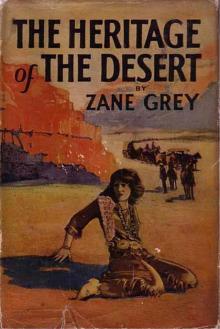 The Heritage of the Desert: A Novel
The Heritage of the Desert: A Novel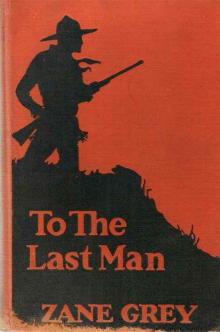 To the Last Man
To the Last Man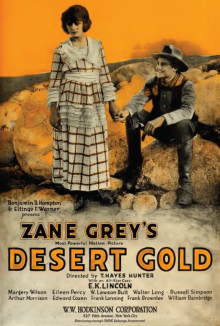 Desert Gold
Desert Gold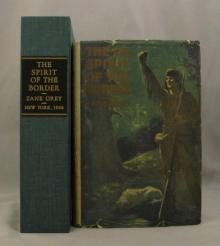 The Spirit of the Border: A Romance of the Early Settlers in the Ohio Valley
The Spirit of the Border: A Romance of the Early Settlers in the Ohio Valley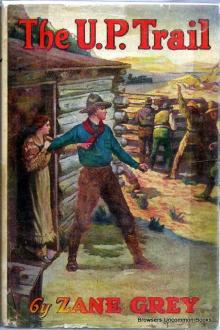 The U. P. Trail
The U. P. Trail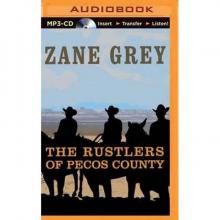 The Rustlers of Pecos County
The Rustlers of Pecos County The Border Legion
The Border Legion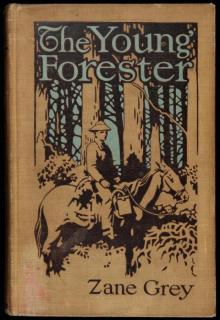 The Young Forester
The Young Forester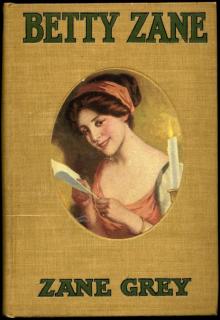 Betty Zane
Betty Zane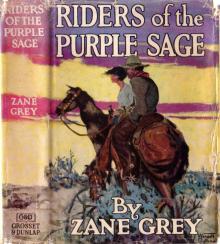 Riders of the Purple Sage
Riders of the Purple Sage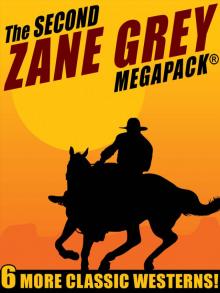 The Second Zane Grey MEGAPACK®
The Second Zane Grey MEGAPACK® The Rainbow Trail
The Rainbow Trail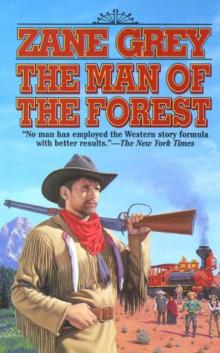 The Man of the Forest
The Man of the Forest The Mysterious Rider
The Mysterious Rider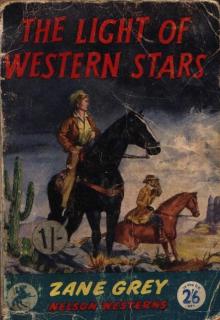 The Light of the Western Stars
The Light of the Western Stars The Last of the Plainsmen
The Last of the Plainsmen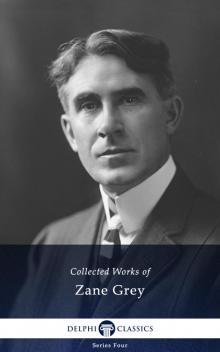 Collected Works of Zane Grey
Collected Works of Zane Grey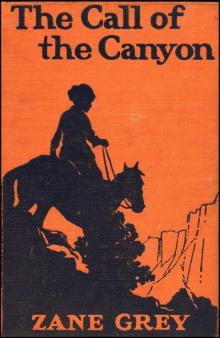 The Call of the Canyon
The Call of the Canyon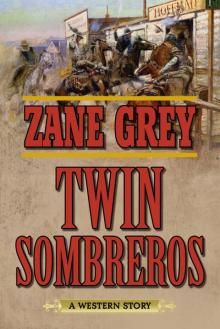 Twin Sombreros
Twin Sombreros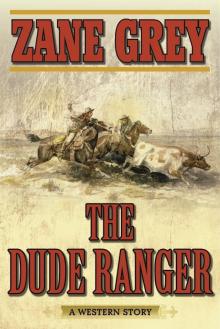 The Dude Ranger
The Dude Ranger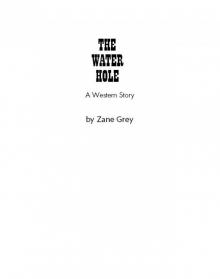 The Water Hole
The Water Hole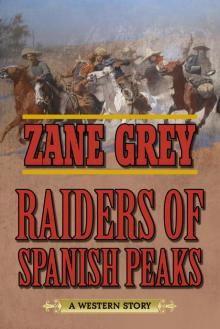 Raiders of Spanish Peaks
Raiders of Spanish Peaks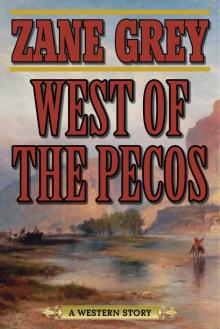 West of the Pecos
West of the Pecos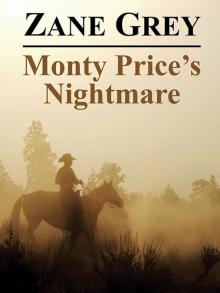 Monty Price's Nightmare
Monty Price's Nightmare Stairs of Sand
Stairs of Sand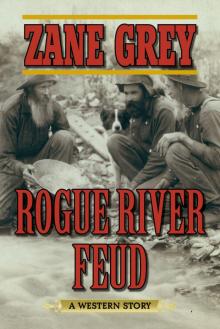 Rogue River Feud
Rogue River Feud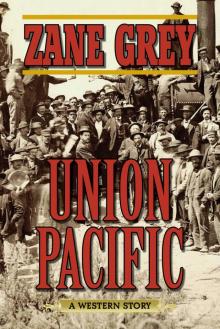 Union Pacific
Union Pacific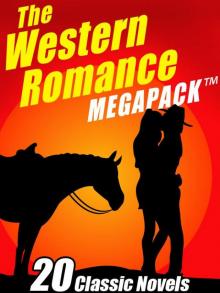 The Western Romance MEGAPACK ®: 20 Classic Tales
The Western Romance MEGAPACK ®: 20 Classic Tales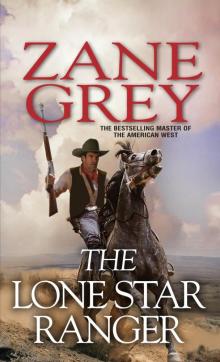 The Lone Star Ranger
The Lone Star Ranger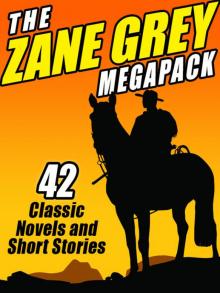 The Zane Grey Megapack
The Zane Grey Megapack Shadow on the Trail
Shadow on the Trail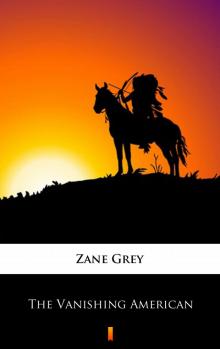 The Vanishing American
The Vanishing American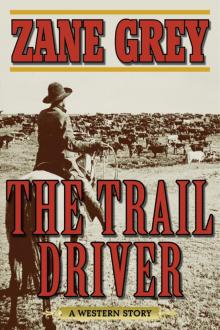 The Trail Driver
The Trail Driver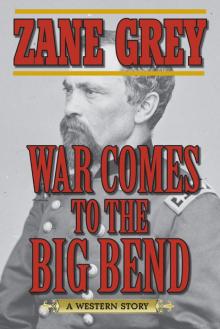 War Comes to the Big Bend
War Comes to the Big Bend The Westerners
The Westerners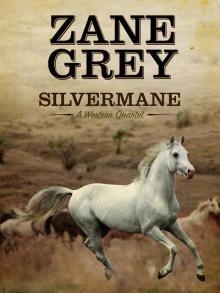 Silvermane
Silvermane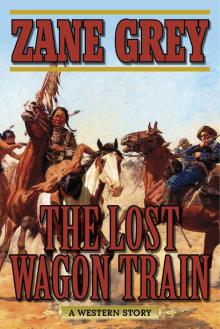 The Lost Wagon Train
The Lost Wagon Train Desert Gold and the Light of Western Stars
Desert Gold and the Light of Western Stars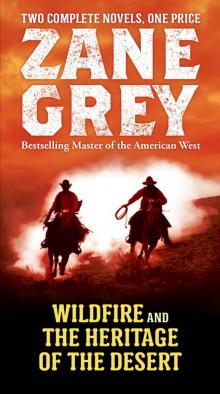 Wildfire and the Heritage of the Desert
Wildfire and the Heritage of the Desert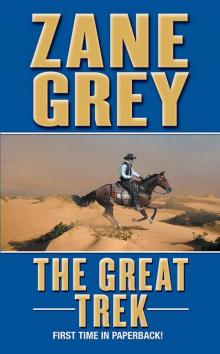 The Great Trek
The Great Trek Cabin Gulch
Cabin Gulch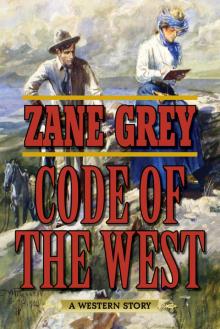 Code of the West
Code of the West Sunset Pass
Sunset Pass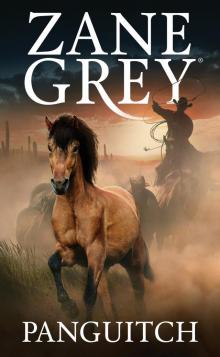 Panguitch
Panguitch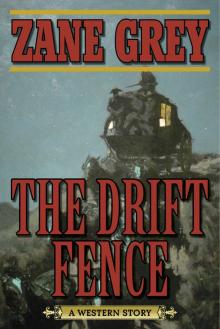 The Drift Fence
The Drift Fence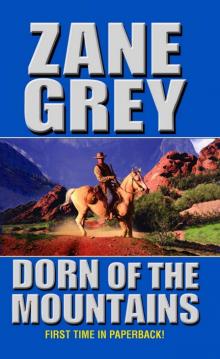 Dorn Of The Mountains
Dorn Of The Mountains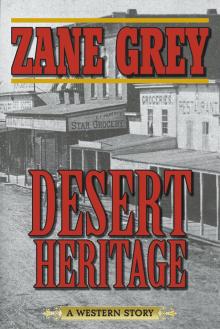 Desert Heritage
Desert Heritage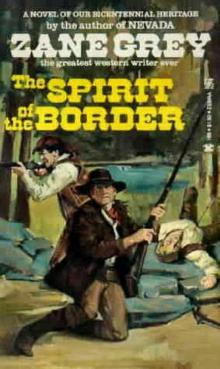 The Spirit Of The Border
The Spirit Of The Border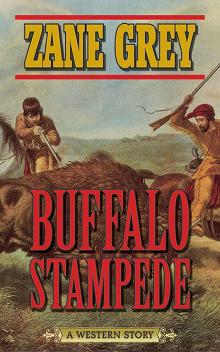 Buffalo Stampede
Buffalo Stampede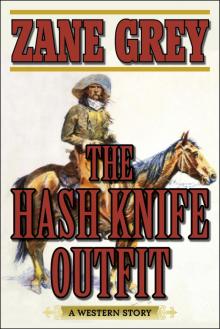 The Hash Knife Outfit
The Hash Knife Outfit The Lone Star Ranger and the Mysterious Rider
The Lone Star Ranger and the Mysterious Rider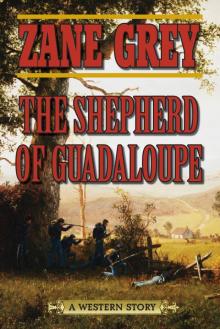 The Shepherd of Guadaloupe
The Shepherd of Guadaloupe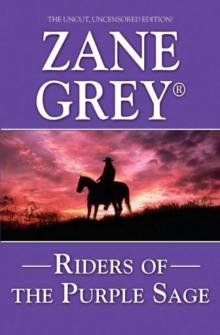 Riders of the Purple Sage (Leisure Historical Fiction)
Riders of the Purple Sage (Leisure Historical Fiction)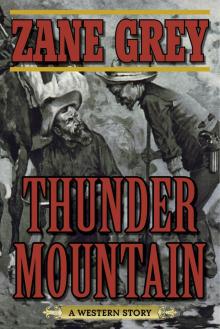 Thunder Mountain
Thunder Mountain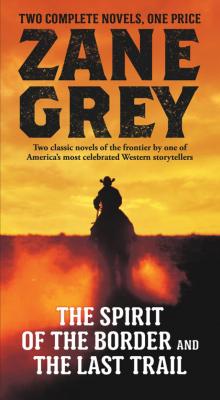 The Spirit of the Border and the Last Trail
The Spirit of the Border and the Last Trail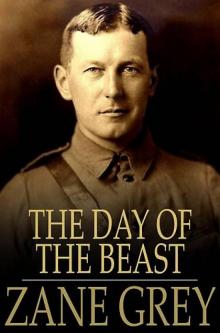 The Day of the Beast
The Day of the Beast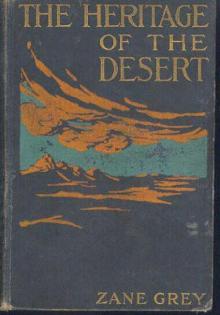 The Heritage of the Desert
The Heritage of the Desert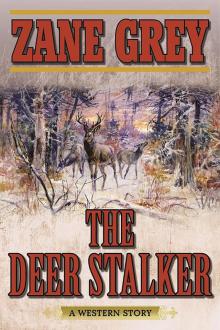 The Deer Stalker
The Deer Stalker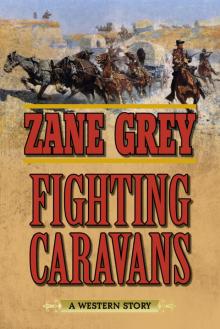 Fighting Caravans
Fighting Caravans